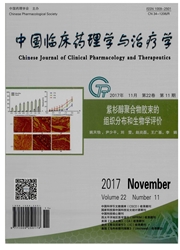

 中文摘要:
中文摘要:
目的:利用精密肝切片(PCLS)技术,建立醋氨酚所致肝切片损伤的体外模型,并探讨CYP2E1活性变化对肝损伤的调节作用,为研究和筛选肝保护药物提供实验依据。方法:利用振荡切片机制备PCLS,建立培养系统。将终浓度为500μmol/L的醋氨酚分别与切片共孵育0、2、4、6h,测定培养基和切片中的谷胱甘肽S-转移酶(GST)和乳酸脱氢酶(LDH)活性。在体给予不同剂量(0.25、0.5、1.0g/kg)的CYP2E1诱导剂乙醇,每天一次,连续3d。末次给药8h后处死动物,取其肝脏制备PCLS,再与500μmol/L醋氨酚共同孵育6h,检测ALT和LDH漏出率。正常PCLS与不同浓度的二乙基二硫代氨基甲酸酯盐(DDTC,CYP2E1抑制剂)(5、10、20μmol/L)、500μmol/L醋氨酚共同孵育6h,检测ALT和LDH漏出率。结果:与常规培养组比较,醋氨酚孵育4、6h组的GST和LDH漏出率显著升高(P〈0.01)。与醋氨酚模型对照组比较,乙醇中、大剂量组LDH漏出率和小、大剂量组ALT漏出率皆升高(P〈0.01,P〈0.05);DDTC各浓度组ALT漏出率则降低(P〈0.05)。结论:PCLS与500μmol/L醋氨酚共孵育4h即能成功地建立体外肝切片损伤的模型。抑制CYP2E1活性可能对醋氨酚所致的肝损伤有保护作用,而上调CYP2E1活性则可能加重醋氨酚所致的肝损伤。
 英文摘要:
英文摘要:
AIM: To establish an acetaminohpheninduced hepatotoxicity model using precision-cut liver slice (PCLS) technique and observe the regulation of cytochrome P4502E1 (CYP2E1) so as to provide experimental basis on investigating and screening new potential hepatoprotective drugs. METHODS: ( 1 ) The PCLS was prepared by the vibratome and co-incubated with 500 μmol/L acetaminophen for 0, 2, 4 and 6 h. The activities of glutathione S-transferase (GST) and lactic acid dehydrogenase (LDH) were measured in the medium and slices. (2)The rots were intragastrically administrated with ethanol in different dosages (0.25, 0.5, 1.0 g/kg) once a day for three days consecutively, then they were at sacrificed 8 h after the last administration and the slices were prepared. And the slices were co-incubated with 500 μmol/L acetaminophen for 6 h and then the activities of ALT and LDH were detected in the slices and medium. (3)Replace the medium after 1 h pre-incubation, the slices were co-incubated with 500 μmol/L acetaminophen and diethyldithiocarbamate (DDTC) (5, 10, 20 μmol/L) for 6 h and the activities of ALT and LDH in the slices and medium were assayed. RESULTS: Compared with regular culture group, the leakage rates of GST and LDH in acetaminophen co-incubated for 4 and 6 h groups were significantly increased ( P 〈 0.01 ). Compared with those in acetaminophen model group, the leakage rates of LDH of ethanol at the dosages of 0.5, 1.0 g/kg and the leakage rates of ALT of ethanol at the dosages of 0.25, 1.0 g/kg increased significantly ( P 〈 0.01, P 〈 0.05). Moreover, the leakage rates of ALT in all concentrations of DDTC decreased remarkably ( P 〈 0.05 ). CONCLUSION: Co-incubation PCLS with 500 μmol/L acetaminophen for more than 4 h is a successful way to establish hepatotoxicity in vitro model. The reduction of CYP2E1 activity might protect the slices from acetaminophen-induced hepatotoxicity, while the increase of CYP2E1 activity might aggravate it.
 同期刊论文项目
同期刊论文项目
 同项目期刊论文
同项目期刊论文
 期刊信息
期刊信息
